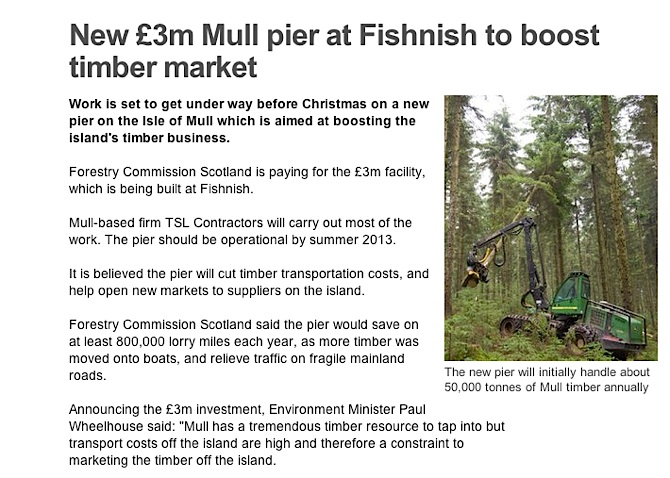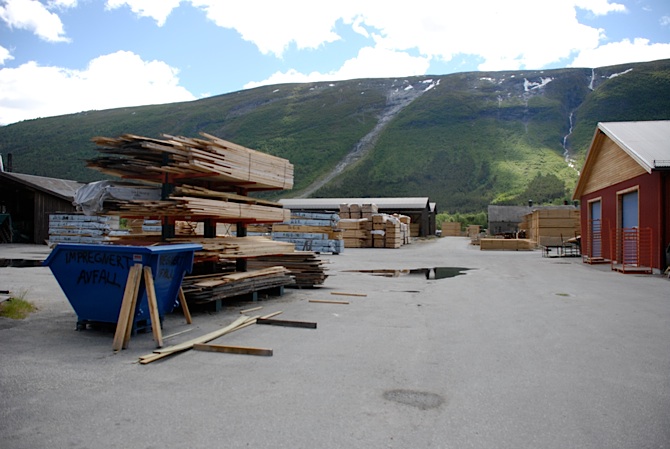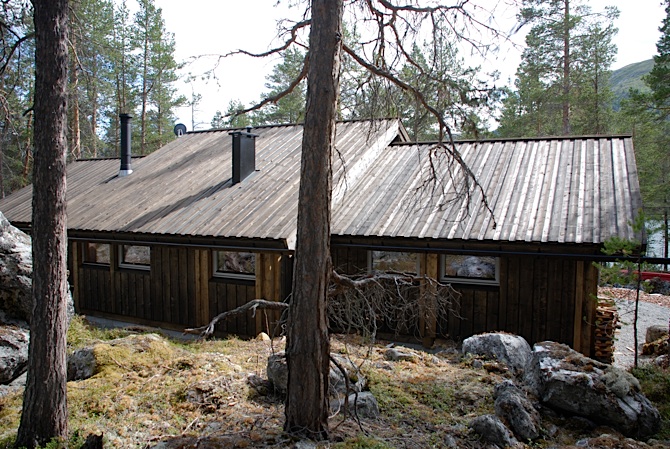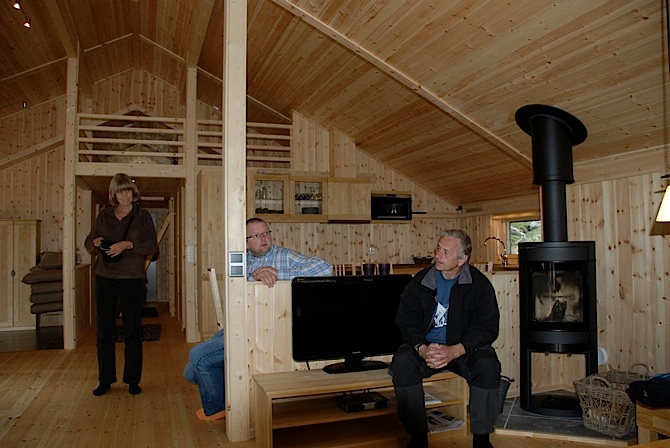£3 million to export jobs from Mull

It was announced today that the Scottish Government is to spend £3m on building a pier to export timber from Mull’s forests and “boost the island’s timber business”. Whilst this may boost the timber harvesting business, it does nothing for the forestry economy and even less for the development of Mull’s economy. It is good news for the state forest service, for Mull’s mainly absentee investment forestry owners (part of a wider problem of absentee private ownership), and for the multinational companies which own the large sawmills in the south of Scotland and north of England. But it weakens the Mull economy by making it easier to extract and export the island’s natural resources.
In Norway, most sawmills “are located in rural areas, close to the raw material sources and with an important role in local economy and employment.” They produce around 2.3 million cubic metres of sawn timber per year from a forest resource of 96,325 square kilometres. Scotland produces 1.7 million cubic metres of sawn timber per year from a forest resource of 13,850 square kilometres.
Here is a medium-scale sawmill in Sjak kommune in Norway.

Sjak kommune has a population of 2280 people and has 9500ha of forest. Mull has a population of 2667 and around 10,000ha of forest,
Sjak kommune has two sawmills, and a timber house factory – illustrated below. All these industries are community-owned. Mull has no sawmills that I am aware of – the nearest one is in Morvern – Sound Wood.


Scotland’s idea of rural economic and industrial development is stuck in an unimaginative rut dominated by elite state and private industrial interests. Those of us who have been long arguing for a different development model have made little or no headway.
No Government Minister would stand up in Norway and proudly announce a £3 million investment to EXPORT an island’s raw materials. This money would be far better spent investing in timber processing and ancillary industries on Mull to boost jobs and investment in the Mull economy.
UPDATE 15 February 2013
The Forestry Commission has published a page with details of the project.
Ah, but sadly we only work on the distorted economics of the “economy of scale”, confusing sustained and sustainable. Maybe one day, localism will be taken seriously here, however, it maybe sometime coming.
The F.C. bought this land with the promise of local jobs, housing in the new forest worker villages and ongoing investment in the local area. Where are the local jobs now, external contractors and minimum ongoing management have depleted the communities they promised so much to?
The forest houses are all sold off and the situation is replicated throughout the Highlands. The original land owners and crofters who gave up their common grazings would be spinning in their graves if they could see what has transpired from their offer to help establish a new industry in their areas.
Surely the pier could also make exporting sawn timber products more viable?
It doesn’t have to just facilitate the resource grab of the forestry commission – it could open opportunities to community groups to add value to their product prior to export if the government insist this pier is open to use by other groups.
No need for a big new pier for that. Existing one would be fine.
I’ll ask questions tomorrow at the Perth & Argyll Forest Forum. I hope the new pier will not be dedicated only for timber transport. Is Mull not one of the few islands that has a local abattoir? If so it could be useful to the other Islands’ livestock producers. With the proposed merging of the 4, Ag, Fishing, Social and Rural EU funds coming in the next CAP, processing facilities for high value niche products could be supported. A quality new harbour could open up an island economy very nicely as long as it’s multi use.
it’s not a harbour – it’s a pier specifically designed for bulk roundwood exports. The critique is a structural argument about how you build an economy. Do you develop a resource colony model where the periphery supplies the raw materials to an industrial core or do you develop a dispersed and vertically integrated economy that minimises low value transport? 60% of what will be leaving Mull will be water (timber at 60% moisture content)
Put that way Andy, it does look like ANOTHER lost opportunity to build resilience into communities.
I thought there was a very large community owned forest in the north of mull??
http://www.nwmullwoodland.co.uk/
There is – yes. http://www.nwmullwoodland.co.uk/
South Germany has a similar situation to Norway with local mills and carpenters -and strangely enough these and our other locally owned industries and banks are doing well: the carpenter I work for (4 employees in a small village) has more orders than we can really handle and we have to subcontract to other (small) carpenters locally. Our wood comes from reasonably local sources. As the finished produch has a far higher markup than lumber I’d have thought it would be far better for Mull to have 3 million pounds of sawmill and skilled carpenters than a pier.
Thanks for your comment – am fascinated at how crude our forestry economy is compared to most of the rest of Europe.
Another thought occurs to me: wasn’t this idea of extracting raw materials what happened to other countries in the colonial era? We went in, made a port and took what we could of the resources, made things with them and sold them at a profit and stuff the countries that we were taking from Looking at those places I think it would be hard to argue that this looting of resources was good for their economies.
By the way, our forests are largely privately owned but the plots are quite small so there are few big landowners like the UK. Many forests are also owned communally by the towns or villages nearby and run by them. Thus has the added dvantage that we can go into most of them for a walk without being shouted at or threatened. It took a while to get used to that.
Typical small minded development designed for the FC and not for the local community. Yet another missed opportunity
I run the small sawmill mentioned in this article, just across the Sound of Mull from the new £3million pier. I process 200-250 tonnes per annum of cedar, oak, larch, douglas fir, basically all the so-called niche timbers that the mainstream industry does not use for a range of reasons (reasons that are fundamental to what is wrong with Scottish forestry but that’s a different discussion). I would like to expand the business to accommodate more value added processing as it typical of sawmills in Norway, Germany, Austria, Italy etc but there are many challenges to scaling up (capital, skills, product design, market perception that big is best). A few businesses have done it, Neil Sutherland’s small house building factory near Inverness is one example.
The situation on Mull is actually no different from many remote Highland forested areas. Here in Morvern, we export 35,000 tonnes of wood per annum, mostly to Cumbria by sea with the better spruce sawlogs going relatively locally to BSW Fort William. It is crazy that we can’t turn a proportion of that natural resource into skilled jobs locally rather than providing just haulage jobs and supplying a few centralised processors. I don’t know what the answer is, with the Association of Scottish Hardwood Sawmillers I am organising a visit to sawmills in north Italy to see if we can learn about how we can develop our sector better here. It’s a start.
Thanks Jake. Good to hear from you. I think the national forest estate needs to come under regional and local democratic control then strategic decisions can be made about how best to develop the resource. You will find a lot of decentralised governance across Europe.